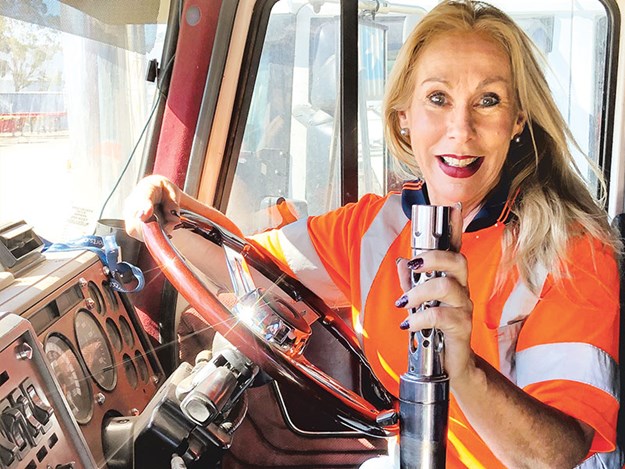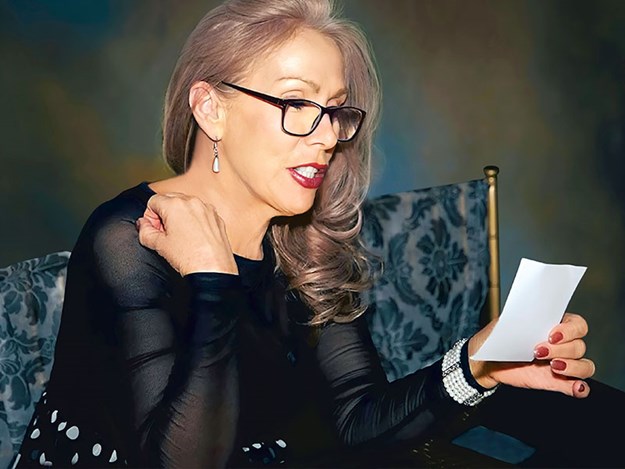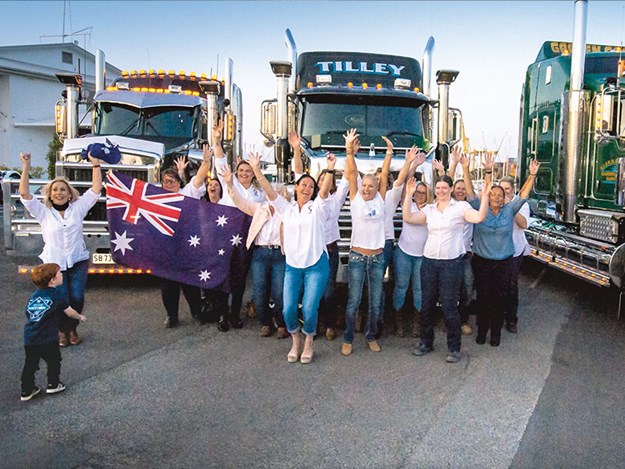Cover story: Lyndal Denny
Lyndal Denny went from reporting aggressive truck driving behaviour to changing sides and becoming a truck driver herself
The reason Lyndal Denny chose to become a truck driver in Australia was, as she puts it, so she could better understand the industry if she walked the talk. So, in 2013, aged 54, she gained her Multi-Combination (MC) license.
Note: In Australia, there are three main truck licenses: Heavy Rigid (HR)—small truck, Heavy Combination (HC)—truck and one trailer, and Multi-Combination (MC)—road train. The industry is sometimes called the HV industry—heavy vehicle.
In a previous life
 |
|
Australian road train driver, Lyndal Denny
|
Lyndal used to drive to work each day on the busy Brisbane–Sydney Pacific Highway. She says she was often scared out of her wits when she looked in her rear-view mirror.
"Forty thousand interstate freighters a week travel that highway, and often, truck drivers tailgated me so closely; I could see the bugs on their bullbar. Even though I’m a confident driver, it was terrifying," she says.
Determined to do something, Lyndal wrote to her local newspaper and was blown away by the massive response from others who had similar experiences. In 2007, she set up a grassroots community campaign and ran a website where motorists could report aggressive truck drivers.
For the next two years, she learned things weren’t as simple as she thought.
For example, she discovered that drivers were under enormous pressure due to tight delivery deadlines. Many were paid per kilometre, so the more distances they travelled, the bigger their pay packets. This created a perfect storm for aggressive truck driver behaviour.
It was then Lyndal reached a crossroads. "I thought I could either get on with my life or look at what I could do to make the roads safer," she says.
So Lyndal decided to find out more about the trucking industry.
"I was sure all truckies drove like lunatics but soon realised it was just a minority. I also realised how few women drove trucks."
When Lyndal’s contract as a regional manager with an Australian Government employment service ended, she decided to get her truck license. She says it was a big transition.
"I’ve always been a frilly female, used to an office environment. It wasn’t long before the business suits and stilettos were replaced by steel cap boots, high-vis work gear, and a hard hat."
Into the driver’s seat
 |
|
Getting out on the road is Lyndal’s happy place
|
One of Lyndal’s early truck driving jobs was working for a mining company in the Pilbara in North-West, Australia. It was located 4000km west of her home in Ballina. She stayed for three years until 2016 but says it was initially a shock.
"I recall walking off the aircraft into the suffocating desert heat and thinking what have I done? It was during the time of the biggest mining boom in the nation’s history."
For Lyndal, the mining expansion coupled with truck driver shortages meant it was like diving off the deep end.
"I found myself driving road trains that pulled up to four trailers. Most newly trained truck drivers would have gained loads more experience before reaching that level. Thank goodness for mobile phone cameras, which allowed me to check any issues with more experienced drivers."
There were other challenges too, she says: "I was working near Marble Bar in Western Australia. I’d followed a mining escort vehicle and a crane through the desert to a remote mining camp to pick up decommissioned mining huts. When we arrived on site, the crane driver loaded the huts onto my truck, and then he and the escort said, ‘Seeing it’s Friday, it’s beer o’clock,’ and buggered off, saying, ‘See you later’.
"There I was, alone, in the middle of nowhere, chaining down the huts. I remember thinking to myself how did a gal like me end up in the wilderness, in this unbearable heat, miles from nowhere? It was surreal."
In the Pilbara, Lyndal drove Macks and Kenworths. "In that tough environment, you need big, grunty trucks with manual transmissions to transport such massive loads," she says.
Lyndal says she felt unsafe at times. She recalls an instance when she was parked on a remote section of highway heading to Darwin.
"I’d pulled up the night before alongside other rigs, but when I woke the following day, there was only me and another truck left.
"I had my toiletries balanced on the truck steps, and a towel hung over the bullbar. I was washing my hair when the truck driver wandered over and told me, ‘You know, if you hang your towel over your bull bar like that, it means you’re up for a bit of fun.’ It sent a chill up my spine; I was up in that truck, door locked, revved up, and gone in a flash."
It was a cautionary experience, so now Lyndal advises women to take care when they work in remote areas.
"I advise them not to use the UHF radio unnecessarily because it has a range of about six kilometres. If there are any dangerous people in the area listening in, they know there’s a female—probably alone—nearby."
With only two percent female heavy vehicle drivers in Australia’s trucking industry, Lyndal says it’s imperative female drivers set boundaries to survive in this male-dominated sector.
"That said, most of our male colleagues are enthusiastic supporters and are happy to share their experiences and pass on their knowledge.
"Unsurprisingly, if you ask one of the boys to show you something, invariably, they’ll try and do it for you. I say, don’t let them. You won’t learn this way; besides, it’s not good to have the blokes do our job for us."
A split shift
 |
|
Lyndal, in her role as CEO of WiTa
|
Lyndal currently divides her day between her morning work as CEO of Women in Trucking Australia (WiTA) and driving road trains four afternoons a week for a major Australian logistics provider—a company she’s been with for eight years.
The day we spoke, Lyndal had finished her shift at 4am, had some sleep, and was up again around 9am to walk her Aussie cattle dog Monty at a nearby beach. After a few more hours’ sleep, she jumped in her truck and was good to go again.
A typical 12-hour shift sees her driving through Australia’s picturesque Barossa Valley to collect a shipment of South Australia’s export wine.
"We’re lucky to have four distinct seasons here, and regardless of the time of year, that valley is one of the most stunning places in the country. I feel blessed to have such a great job."
Since beginning her late-start driving career, Lyndal says she’s discovered many things about herself she never knew.
"As an office worker, I was a pampered desk jockey who relied on others when the going got tough. I was always polite and didn’t like to create waves. If something was too hard to do today, I’d do it tomorrow.
"Now, because of our work’s challenging nature, I’ve become resilient and resourceful. I’ve also discovered my fellow female truckies are robust, capable, and confident women."
Women in Trucking Australia
 |
|
Australian women truck drivers put out the call for their Kiwi counterparts to get on-board
|
WiTA was set up by Lyndal and fellow truck driver Candice Lureman in 2019. The organisation gives Australian female heavy vehicle drivers a voice and offers support, training, and mentoring to newly licensed drivers and women wanting to break into the industry.
Having struggled to find support early on in her career, Lyndal saw the need for an organisation that would offer that.
"When I gained my HR license, I couldn’t find anything. However, this planted the seeds for establishing Women in Trucking Australia. Our initial approach was to find women drivers, so we set up the WiTA Facebook page and were delighted when they responded in droves. It was as if they’d been waiting for this moment. Three years later, we’ve established a solid foundation. While WiTA is still in its infancy, the plan is for it to become the peak body for Australian female heavy vehicle drivers."
How about such an organisation for New Zealand women truck drivers, I suggest?
"There’s a fantastic opportunity to set up an organisation like WiTA in New Zealand," Lyndal says.
"We would be delighted to work with any women there because we’ve already gone down that path. We will do anything to work together (while taking the mickey out of each other, of course!). If you’d like to jump onto our Facebook page, you can instantly tap into the experiences of thousands of female heavy vehicle drivers. We’d love to help Kiwi women any way we can."
Lyndal says women are a vital untapped resource when it comes to trucking.
"We’re working hard to show women it’s a great career choice by illustrating what we do. As we like to say, ‘people can’t be what they can’t see,’ so we take our job of shining a light on the vocation seriously. I liken it to turning a ship as big as the Queen Mary around, but it’s finally happening. Our goal is to achieve a 50/50 gender balance by 2050."
For more information, visit wita.com.au or their Facebook page facebook.com/WomenTruckingAustralia.
Find new and used heavy machinery for sale in NZ
Keep up to date in the industry by signing up to Deals on Wheels' free newsletter or liking us on Facebook.





.jpg)


.jpg)


.jpg)
.jpg)
-(1).jpg)
-(1).jpg)
.jpg)

